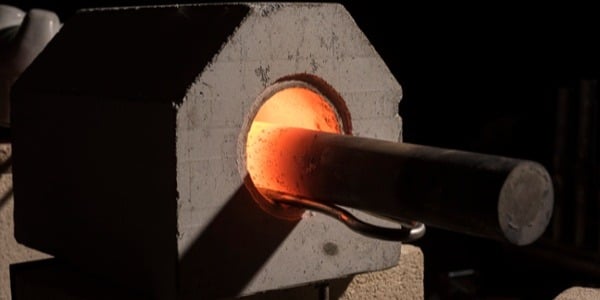Curing Material on an Aluminum Mandrel
Objective Heat a customer supplied aluminum cylinder to 80-120°C for a material curing application. More application notes
Processes
Processes: More
Processes: More

Industries:
Industries: More
Industries: More
Industries: More

Products:
Products: More
Services:
Services: More

Learn:
Learn: More
About:


Induction heating has considerable advantages over other common heating methods in specific applications. Is yours one of those applications?
Induction heating offers many benefits to manufacturing processes because it is a rapid, energy-efficient, flameless method of heating electrically conductive materials. A typical system involves an induction power supply, workhead with a copper coil and a chiller or cooling system. Current flows through the coil to create an electromagnetic alternating field. When a conductive part is placed inside the coil, current is induced to run through it. Current flow combined with the resistance properties of the conductive part results in heat generation.
Induction directly heats conductive materials such as metals. Nonconductive materials are sometimes heated with a conductive susceptor. Due to hysteresis, magnetic materials are heated more easily than nonmagnetic materials; consequently, nonmagnetic materials often require more power. Metals with high resistivity like steel heat quickly, while low-resistivity metals like copper or aluminum require more heating time.
The induced current will be most intense on the surface of your part. In fact, more than 80% of the heat produced in the part is produced on the “skin,” or surface. Consequently, larger parts and parts that require through-heating take more time to heat than those that are thin or small.
Lower-frequency, higher-power systems are generally suited for heating larger parts that require through heating. Lower-power, higher-frequency systems are often the right choice for surface heating. As a general rule, the higher the frequency, the shallower the heating of the part.
The output power of your induction heating power supply determines the relative speed at which your part is heated. The mass of the part, rise in temperature and heat losses from convection and conduction need to be considered. Often, the induction equipment manufacturer can help you make this assessment.
Induction can generate a significant change in temperature, but, generally speaking, more power is needed to accommodate a significant temperature change and will impact your power-supply choice. The rate of temperature change also affects your power-supply choice. The faster the rate of change, the more significant the power requirement.
Your coil, which is generally water-cooled and made of copper, needs to follow the shape of your part and take the variables of your process into account. An optimal coil design will deliver the right heat pattern to your part in the most efficient way. A poorly designed coil will heat your part more slowly and deliver an improper heating pattern. Flexible coils are now available and work well with large parts and unique part geometries.
The part being closely coupled with the coil elevates the flow of current, which increases the amount of heat generated in the part. Coupling enables faster and more efficient heating, which can increase manufacturing efficiency. Poor coupling has the opposite effect.
Induction requires cooling from a chiller or cooling system. Lower-power systems generally require a compact water-to-air heat exchanger, while a higher-power system may require a larger water-to-water heat exchanger or chiller. Additionally, you will need space for the induction heating power supply and workhead. Generally speaking, an induction system will save considerable space over an oven, especially when you consider that the workhead can be placed a significant distance away from the power supply. Of course, you also need to be sure your facility can handle the amount of power the system requires.
Will you need to measure and store heating data? Some induction solution providers can offer a full system that includes an optical pyrometer and temperature-monitoring software so such data can be recorded and stored. A comprehensive solution can lead to a smooth installation and start-up.
Many induction manufacturers have expertise with certain applications, and if they’ve worked with your application, it will provide peace of mind. Additionally, some providers offer laboratory testing and a tailored system recommendation based on your heating requirements. This type of service takes the guesswork out of selecting a system and helps you account for the aforementioned factors.
In conclusion, induction heating has considerable advantages over other common heating methods. Buying the right system for your application’s needs and ensuring it meets any needs you may have for it in the future will help your company fully benefit.

Objective Heat a customer supplied aluminum cylinder to 80-120°C for a material curing application. More application notes

In today’s manufacturing landscape, efficiency, precision, and sustainability are critical. Induction heating—a process that uses electromagnetic...

When it comes to many manufacturing processes, including this forging application, precision and efficiency are critical. Traditional heating methods...